Director’s foreword
Welcome to the second edition of the Department of Mines and Petroleum’s (DMP) Environment eNewsletter for 2017.

The Mining Rehabilitation Fund (MRF) team is already busy checking reports with the MRF reporting period closing on Friday 30 June 2017. Please remember there are infringements if you are late lodging your data, but we are here to help; so please refer to the ‘MRF Update’ for contact details and information that will assist you with your submission.
In this issue, operator’s are also reminded about the ‘Environment Plan Summary’ submission process where operators are required to submit a public disclosure document at the time of their Environment Plan to improve government transparency.
Programme of Work electronic forms for exploration are currently planned to be phased out during the course of this year with spatial lodgement then becoming mandatory. More industry training sessions are being scheduled, so please see the ‘Programme of Work spatial lodgement update’ for contact details if you wish to enquire about future sessions. So far the new system is running very smoothly with most users finding it easy to use.
Our recent focus has been to deliver the Government’s priority of establishing the new Department of Mines, Industry Regulation and Safety as of 1 July 2017. From this date the new Department will then transition towards implementing a new integrated service approach to delivering the priorities of the government.
Best wishes for a productive end of financial year.
Ms Karen Caple
Acting Executive Director Environment
Changes to petroleum Environment Plan Summary submission process
The Department of Mines and Petroleum (DMP) is committed to ensuring that regulatory, decision making and investment attraction processes, together with the technical information and data supporting them, are publicly available for the benefit of the Western Australian community.
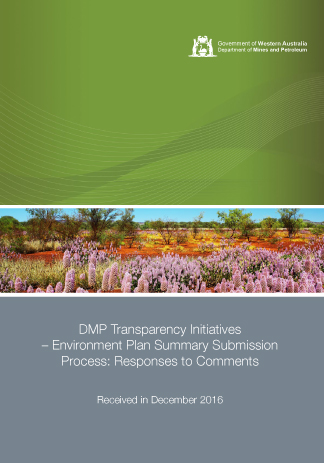
DMP implemented a revised Environment Plan (EP) Summary submission process in March 2016 which requires petroleum operators to submit their EP Summary document at the same time as the EP lodgement.
The change to the submission process was implemented to align with the department’s transparency policy and ensure timeliness and accessibility of information to the community were addressed.
DMP provided the opportunity for all relevant stakeholders to provide feedback on the “EP Summary submission process” and responses to comments received have been published on the DMP website.
DMP thanks all participants for their feedback and comments. DMP is committed to improving transparency through public disclosure of environmental data and information and will continue to review the transparency process.
The EP Summary Submission process flowchart is available on the DMP website.
Criteria for fast-tracking environmental assessments
The
Department of Mines and Petroleum (DMP) has seen an increase in the number requests from proponents for their environmental applications to be ‘fast tracked’ so that they can receive their decision earlier than the DMP target timeframe.
Fast-tracking individual applications usually results in decisions on other applications being delayed. Therefore environmental applications are processed in the order in which they are received, with the aim to have all applications determined within the target timeframe.
DMP reminds proponents that any decision to fast-track an assessment can only be approved by the Environment Division, Executive Director or Director Operations. DMP will only consider ‘fast-tracking’ applications in exceptional circumstances and specifically where it is demonstrated that the approval is needed to:
- address an immediate safety hazard,
- prevent significant environmental harm from occurring or continuing,
- respond to an emergency event and
- address an error made by DMP in issuing a previous approval.
DMP does not consider that stand-by costs being borne by proponents as an adequate reason for fast-tracking approvals. Further information on environmental application assessment timeframes and prioritisation of application requests can be located on the DMP Website.
Stakeholder workshops - new mining proposal guidelines
The Department of Mines and Petroleum (DMP) ran a series of workshops in February and March to assist industry with the new Guideline for Mining Proposals in WA - April 2016. DMP has been very pleased with the success of the workshops, which covered recent learnings from the first completed assessments and provided examples of risk assessments and environmental outcomes.
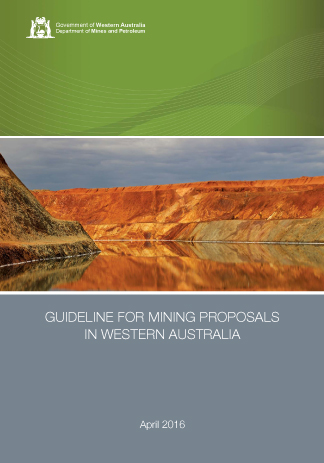
The workshops enabled tangible examples to be discussed and assessed among groups of industry professionals and DMP Environmental Officers. The aim was to increase the level of understanding of the new risk and outcome based framework for industry and Departmental officers.
Below is a summary of some of the key issues that were discussed at the workshops.
Environmental Risk Assessments
Risk Criteria:
It is recognised that mining operations can have a number of associated risks such as health, safety and financial. It is an environmental risk assessment that is required for Mining Proposals and therefore the consequence ratings must be defined in environmental terms to provide an appropriate context; criteria that are focussed only on financial costs or corporate risks are not suitable and may skew risk rankings.
Link to Baseline Data:
Baseline data is important when identifying project risks. There is no requirement to include risks which are not identified by the environmental baseline data.
Environmental Consequence:
Generally, the most common scenario where the environmental consequence may be reduced is through the elimination or substitution of a risk pathway, this often occurs during the project planning phase. Examples include altering the planned location of infrastructure to avoid direct impacts to threatened flora, or opting for small scale fuel storage rather than the storage of large volumes of hydrocarbons on site.
As such, it is expected that the risk assessment included in the Mining Proposal will have progressed passed the project planning phase and will likely only include those risks that cannot be avoided or minimised through elimination or substitution and instead require management by control or mitigation. If the consequence within the risk assessment is reduced post treatment, then context should be provided.
Fully Describe the Risk, Pathway and Potential Impacts:
It is important to fully describe each risk, pathway and potential impact as this demonstrates that the risks are understood and allows for the adequacy of the proposed treatments to be assessed. There should be a direct link between the cause/source of the risk and the proposed treatment measures. This also enables the identification of any potential gaps in risk identification.
Additional Information or Further Attachments to the Mining Proposal:
For inherent (raw) risks that are considered high and require comprehensive and/or specialised management measures, the Mining Proposal will need to contain a comprehensive description of these management measures (eg. design drawings, management plans). This may not fit within the risk assessment table and can be included as an appendix, however the key management points should still be included in the risk assessment.
For risks that are considered to be lower and can be readily managed by standard management practices, less detail is required on these management measures in the Mining Proposal.
Environmental Outcomes
You only need to consider drafting site-specific environmental outcomes for risks that:
- Are rated as a moderate or greater risk (pre-treatment).
- Are not directly regulated by another agency.
There is not a ‘hard and fast’ rule on how many outcomes need to be drafted and what environmental risks need to be covered. Their primary purpose in the Mining Proposal is to be an appropriate set of outcomes that the applicant is promising to achieve, therefore they should focus on the main environmental risks of the site and have clear performance criteria to allow them to be measured.
Performance Criteria:
Performance criteria are used to measure the achievement of environmental outcomes. While performance criteria generally need to be focussed on the final environmental end point of a particular issue, it can be appropriate to use design criteria or operational controls as performance criteria in the Mining Proposal. This is especially relevant to environmental risks that may have long environmental lag times and/or risks that need specific engineering controls or acute site management. Examples could include:
- Meeting design criteria for high risk landforms such as tailings storage facilities (TSF’s) or waste dumps.
- Managing the pre-stripping of topsoil and storage of rehabilitation materials.
- Operational controls and/or design criteria for managing high risk materials (eg. potentially acid forming materials, radioactive materials, etc.).
Monitoring:
Monitoring is necessary to measure performance against the environmental outcomes. Monitoring details may include the location of monitoring sites, reference or control sites, parameters, frequency, timing and methodologies for data collection and analysis.
Monitoring activities are important in determining when trigger actions are required and specific monitoring is required for each performance criteria at an agreed schedule. Monitoring must be designed to be sensitive to early changes in the environmental conditions on site, so that corrective or contingency actions can be implemented well in advance of an environmental outcome or performance criteria being breached.
Transition of Existing Sites
While the workshops did not specifically focus on the transition of existing sites to the new Mining Proposal Guideline, it is a frequent question and topic of conversation. DMP is planning to draft some guidance to further assist sites that need to transition. In the meantime, here are a few helpful things to note:
- When an existing site uses the new Guideline, all existing and proposed mining activities need to be included in the Mining Proposal.
- The new Mining Proposal is an opportunity to look at the mine site in a holistic fashion and develop one set of environmental outcomes for the whole site.
- While it is an opportunity to take a fresh look at the site, DMP will not require past commitments to be changed to align with modern day standards (provided they meet DMP’s broad environmental objectives).
- In terms of identifying past commitments, it is suggested that the existing table of closure commitments required in the Mine Closure Plan be broadened to include all the main environmental commitments from past Mining Proposals (or Notices of Intent) and be included in the Environmental Legislative Framework section of the Mining Proposal.
Further Guidance
DMP is currently drafting some additional guidance notes on risk assessments and environmental outcomes. This guidance will be based on the outcomes of the workshops and feedback from the first assessments. The draft guidance will soon be released for stakeholder comment.
If you have any further queries, please contact mpreformenquiry@dmp.wa.gov.auProgramme of Work spatial lodgement update
The Department of Mines and Petroleum’s (DMP) new online spatial system for the lodgement of Programme of Work (PoW) applications has been in use since 1 March 2017. The updated map-based application allows users to enter their proposed activities directly into the system, either by uploading existing spatial files or by digitising proposed activities on the screen. The system then conducts automatic checks by intersecting the proposed activities with other data layers of environmental and cultural significance, alerting the user of the results. Any areas which need follow-up or clarification can then be addressed before the application is submitted.
Stakeholder feedback and improving the system
The PoW spatial system aims to improve application quality and reduce assessment times. DMP has received excellent stakeholder feedback on the new system, with 80 per cent of users rating it as easy to use. More than 100 PoW spatial applications have been received so far.
Since the system launch, a number of updates to improve system functionality have been implemented. To date, these updates have included:
- publishing of an upload format guide to provide guidance around shape file uploads, as well as some template shapefiles,
- improved system feedback when uploading shape files,
- improved quality of map generated from the application,
- live feedback on distance and area whilst digitising activities and
- new test pits activity category.
The system is being continually updated based on user feedback. Should you have any feedback or comments on the system, or ideas for improvement, these can be forwarded through to PoWSpatial@dmp.wa.gov.au.
Phase-out of PoW-E electronic form
Currently the new spatial system and the old electronic PoW forms are running in parallel ie. you can still apply for a Programme of Work for exploration (PoW-E) using the old electronic form, however the intention is to phase out PoW-E during the course of this year at which time PoW-Spatial will become mandatory.
PoW for prospecting (PoW-P) forms will continue to be accepted in hard copy and online through DMP Submissions.
PoW spatial lodgement training sessions
To assist tenement holders to become familiar with the new system and spatial lodgement, DMP has been holding industry training sessions in Perth and Kalgoorlie since February, where individuals are able to trial the new system and have their queries answered by DMP Environmental Officers. More than 100 people have attended these training sessions to date.
To enquire about upcoming training sessions please email PoWSpatial@dmp.wa.gov.au.Mining Rehabilitation Fund (MRF) update
There is less than one month to go before the end of the MRF 2016/2017 reporting period. The MRF team has been busy encouraging tenement holders to complete their MRF reports early and there has been a fantastic response so far.
The MRF reporting period closes at 11:59pm on Friday 30 June 2017. If you have not lodged your report, please complete it as soon as possible and don’t leave it until the last moment. The MRF team wants to avoid sending out infringement notices this year and will help tenement holders to complete their reports on time.
If you do not have access to a computer, ‘public access’ computers are available in the Library at Mineral House on Level 1 and at each of the regional offices where staff can assist you in completing your MRF report. It is also possible to submit your report using a smartphone or tablet.
The MRF team is available to assist you if you have any questions, so please don’t hesitate to get in touch by e-mail, on the telephone or in person.
E-Mail : mrfenquiry@dmp.wa.gov.au
Phone : (08) 9222 3162
For more information on MRF reporting and how to lodge your report, please refer to the following documents located on the MRF Webpage under the section headed “What is the MRF?”.
Mining Rehabilitation Fund FAQs
Mining Rehabilitation Fund Guidance
MRF annual audit program
The MRF Team runs an annual audit program to ensure tenement holders submit accurate data and fulfil their MRF reporting requirements. Historical MRF reports for a tenement can also be included in an MRF Audit where discrepancies are noted.
The Department of Mines and Petroleum (DMP) regulates approximately 20,000 mining related tenements. The MRF Team is aiming to audit every tenement within a five year audit cycle and is currently on track to meet a target of auditing 4,000 tenements for the 2016/2017 financial year, having already audited 3,002 tenements by the end of March 2017.
Audits are undertaken on tenements based on risk and audit frequency. Typically, higher risk tenements are audited more frequently.
DMP would like to acknowledge the cooperation of all tenement holders who have been audited to date, especially those who have provided timely responses to resolve discrepancies found during audits.
Abandoned Mines Program update
As a part of the Department of Mines and Petroleum’s (DMP) Abandoned Mines Program, rehabilitation efforts and remedial actions are continuing at the Ellendale Diamond Mine, the pilot sites at Black Diamond Pit Lake and the Pro-Force Plant Site.
Ellendale Diamond Mine
Ellendale is located approximately 120km east of Derby in the West Kimberley region of Western Australia. Ellendale includes the E4 and E9 pits, waste rock landforms and several tailings storage facilities (TSFs). Ellendale’s largest TSF was operational when the site was abandoned and covers an area of more than 2.5 square kilometres. Given the nature of the Kimberley’s wet season and the construction material of the TSF’s walls (red pindan soils or tailings), regular monitoring of the TSF is required.
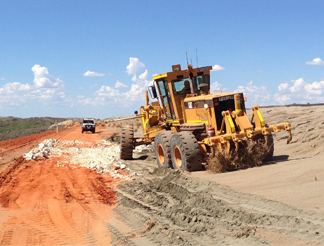
The Kimberley Region has experienced a record breaking wet season with, according to the Bureau of Meteorology, the 2016-17 summer rainfall across the Kimberley averaging more than 900mm and was the wettest summer on record. Remediation works that were undertaken by DMP in December 2016 and January 2017 have significantly reduced the impact the 2016-17 wet season has had on the TSF, with the facility remaining largely structurally sound. The remediation work involved the removal of an internal wall to reduce the likelihood of the facility overtopping, as well as the construction of 45 rock beds and 19 catchment baffles using rock from a nearby quarry. These rock beds and baffles were installed to reduce the size of water catchment areas across the top of the TSF to avoid large pools of water forming.
The main TSF at Ellendale is still an asset for the site, with further monitoring of the facility expected to occur prior to the 2017-18 wet season. DMP is taking all reasonable steps to ensure the remaining assets of Ellendale are managed to support and encourage the re-commencement of mining.
More information regarding Ellendale can be found via a link on the Abandoned Mines webpage.
Black Diamond Pit Lake
The historical abandoned mine site known as Black Diamond is located off Ferguson Road in the Shire of Collie, within the Allanson town site boundary, in the South West of Western Australia.
Following the completion of civil works at Black Diamond to reduce community safety risks, DMP has prepared a Revegetation Plan to ensure stakeholder alignment regarding how the remediation project will be completed.
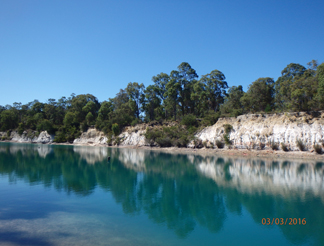
Approval of the Revegetation Plan was provided by the Shire of Collie and the Department of Lands in April 2017. Endorsement of the Revegetation Plan was also provided by the Black Diamond Working Group, which consists of adjacent landowners, government agencies and members of the local community.
Given their experience and knowledge regarding revegetation in the Collie region, DMP consulted with Griffin Coal to maximise the success of revegetation. In addition to providing technical expertise, Griffin Coal has also generously provided native seed for the project and assistance with ensuring it is properly distributed across the project area.
DMP placed an advertisement in the Collie Mail seeking interest from revegetation contractors. Scopes of Work for weed control, mulching and seedling planting were sent out to those companies that expressed interest in this work.
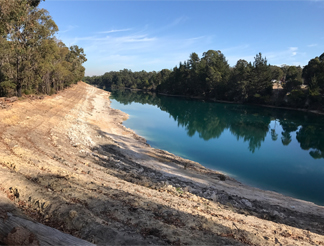
The revegetation of Black Diamond is expected to involve the distribution of approximately 4kg of native seed, the planting of 5000 sedges, 600 shrubs and trees, the control of weeds in winter and spring 2017 and the spreading of approximately 1ha of mulch .
DMP is also working closely with the Allanson Primary School to investigate options to involve the students of the school with this exciting project.
Timing of the revegetation works will be largely determined by rainfall events to maximise the likelihood of success. It is anticipated that this work will be completed by the end of the 2017 wet season.
More information regarding Black Diamond can be found using the link on the Abandoned Mines webpage.
Pro-Force Plant Site
The Pro-Force Plant Site is approximately two kilometres southeast of the Coolgardie town-site and is adjacent to a public use area and water reserve ‘the Gorge’ which is regularly visited by locals and tourists, particularly when it is full of water.
Rehabilitation activities undertaken to date at the Pro-Force site have been successful in removing the immediate public safety risks associated with abandoned processing infrastructure, old tyres, scrap metal and rubbish.
In consultation with the Shire of Coolgardie, a revegetation strategy was prepared for the western part of the Pro-Force site that did not overlap with existing mining tenure. The revegetation involves planting 100 salmon gums around the access road to the water reserve that will provide shade and improve the visual appeal of the area.
DMP will continue to work with underlying tenement holders to ensure that any rehabilitation works undertaken at the site does not affect mining and exploration plans for the area. The revegetation is expected to be completed in late winter 2017.
More information regarding the rehabilitation activities undertaken for the Pro-Force project can be found on the Abandoned Mines webpage.Public consultation
The Department of Mines and Petroleum (DMP) is committed to stakeholder engagement.
Effective and ongoing stakeholder engagement enables better planned and more informed policies, projects and services, including a greater understanding and management of issues and potential risks. For stakeholders, the benefits of engagement include the opportunity to have their issues heard and to contribute to the decision-making process.
When documents are open for public consultation they are located on DMP's Consultation webpage.
Public consultation closed
Public consultation has now closed for the items listed below. Closed items will remain accessible on the Consultation webpage for a minimum period of 12 months.
|
Summary |
Date Closed |
|
Draft Partnership Guideline developed to support DMP's Abandoned Mines Program. |
6 January 2017 |
|
Changes to Environment Plan Summary Submission Process – for stakeholder comment |
30 November 2016 |
|
Draft Guidance – Materials Characterisation Baseline Data Requirements for Mining Proposals |
29 April 2016 |
|
Draft Guideline for the Development of Petroleum and Geothermal Environment Plans in Western Australia |
15 April 2016 |
|
Draft Guideline for the Development of an Onshore Oil Spill Contingency Plan |
4 March 2016 |
|
Draft Guideline Groundwater Monitoring in the Onshore Petroleum and Geothermal Industry |
4 March 2016 |
|
Procedure for Declining and Refusing Environmental Applications - draft for public consultation |
31 January 2016 |
Approvals by Mineral Field - Environment Minerals
1 January to 31 March 2017
Mining Proposals
You can view mining proposals on-line using the department’s MINEDEX system. Select ‘Environmental Registrations’, enter the ‘Registration ID’ number listed below in the relevant field, then press ‘Execute Search’.
View the Environment Minerals Approvals by Mineral Field PDF.
Approvals by Region - Environment Petroleum
1 January to 31 March 2017
Environment Plans, Bridging Documents and Written Notifications
You can view petroleum and geothermal environmental proposals on-line using the department’s Environmental Assessment and Regulatory System (EARS) system. Enter the ‘EARS ID’ number listed below in the relevant field, then press ‘Search’.
View the Environment Petroleum Approvals by Region PDF.
Approvals Performance Report
1 January - 31 March 2017
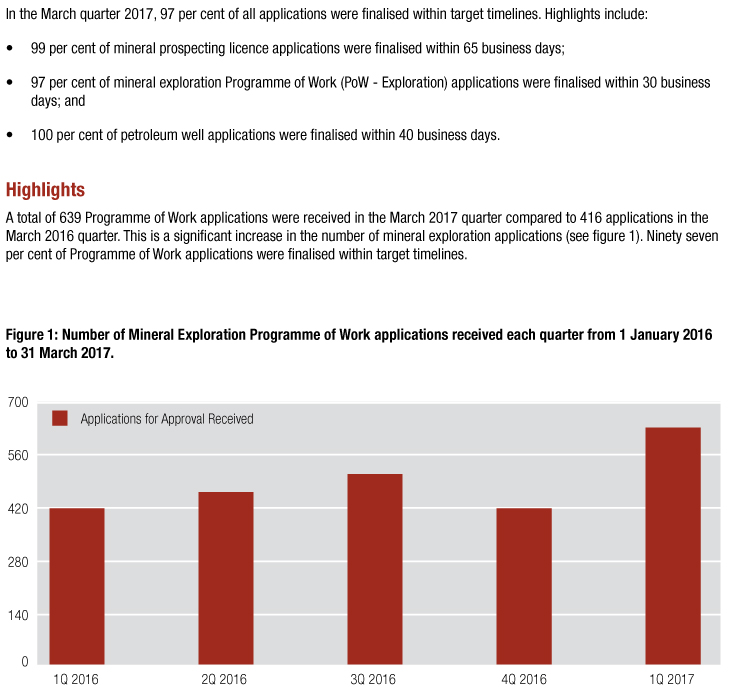
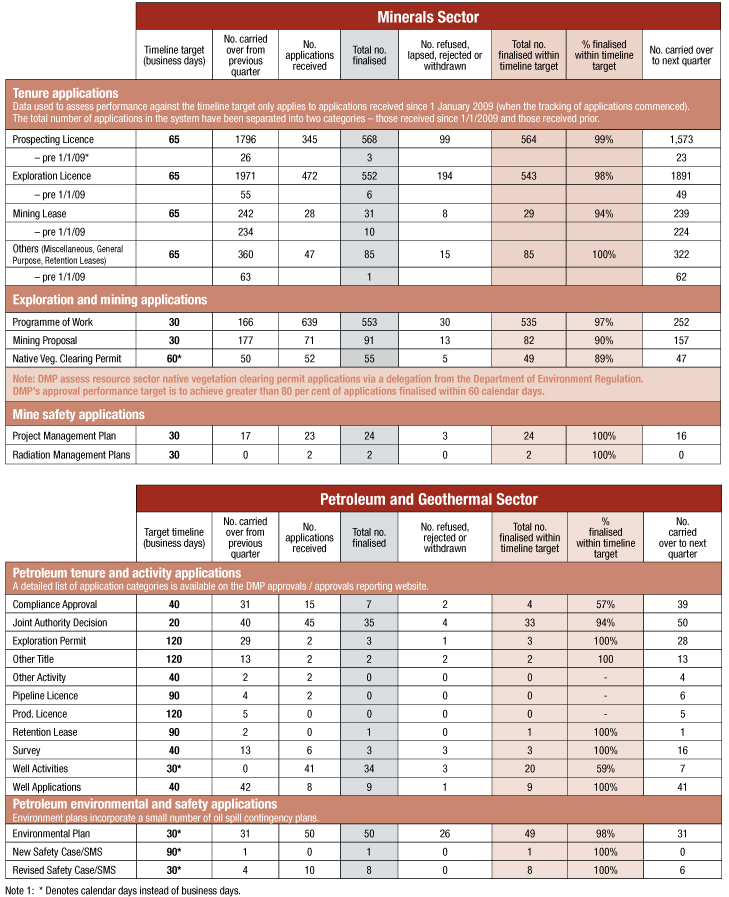
Contact details for the Environment Division
Please keep these contact details handy for the Department of Mines and Petroleum's (DMP)s Environment Division.
Minerals assessment or compliance
The map linked here provides you with the contact details of the DMP Environmental Officers responsible for your inspectorate/mineral field area.
Inspectorate map and responsible Environmental Officers
Petroleum environment operations
General enquires, notification of commencement or completion of a petroleum activity and notification of reportable environmental incident.
Email: petroleum.environment@dmp.wa.gov.au
EARS / EARS 2 online system
General application and compliance reporting enquiries
Email : EARSManager@dmp.wa.gov.au
Phone : (08) 9222 3535
Mining Rehabilitation Fund (MRF)
Mining Rehabilitation Fund enquiries
Email : mrfenquiry@dmp.wa.gov.au
Phone : (08) 9222 3162
Golden Gecko
Entry forms and details of how to enter the 2017 Golden Gecko Awards are available on the Golden Gecko webpage.
For any further enquiries
Email: golden.gecko@dmp.wa.gov.au
Phone: (08) 9222 3102
PoW spatial training
Registration and general enquiries
Email: PoWSpatial@dmp.wa.gov.au
Mining Proposal (MP) Reform
Mining Proposal Reform enquiries